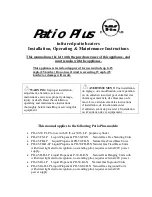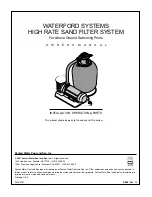
Pennant Pool Heater
Page 9
local applicable codes (see Figure 3). Consider the
following when installing the terminal:
1.
Through-the-wall vent terminals must terminate
at least 7-feet above a public walkway.
2.
Locate the vent terminal so that vent gases
cannot be drawn into air conditioning system
inlets. The National Fuel Gas Code requires that
it be at least 3 feet (0.9m) above any such inlet
that is within a horizontal distance of 10 feet (3m).
3.
Locate the vent terminal so that vent gases
cannot enter the building through doors,
windows, gravity inlets or other openings. The
National Fuel Gas Code requires that it be
located at least 4 feet (1.2m) below, 4 feet (1.2m)
horizontally from, or 1 foot (0.3m) above such
openings. Whenever possible, locations under
windows or near doors should be avoided.
4.
Locate the vent terminal so that it cannot be
blocked by snow. The National Fuel Gas Code
requires that it be at least 12 inches (30 cm)
above grade, but the installer may determine it
should be higher, depending upon local
conditions.
5.
Locate the terminal so the vent exhaust does not
settle on building surfaces and other nearby
objects. Vent products may damage such
surfaces or objects.
6.
Locate the terminal at least 6 feet (1.8m)
horizontally from any gas or electric metering,
regulating, or relief equipment.
7.
If the Pennant uses ducted combustion air from
an intake terminal located on the same wall,
locate the vent terminal at least 3 feet (0.9m)
horizontally from the combustion air terminal,
and locate the vent terminal at least 1 foot (0.3m)
above the combustion air terminal.
8.
Note that side wall vent terminals for models
750-2000 are shipped with reducers for the vent
collars, to accommodate horizontal vent sizes,
shown in Table 1.
WARNING
The outdoor vent terminal gets hot. Unit must be
installed in such a way as to reduce the risk of
burns from contact with the vent terminal.
2.3.2 Side Wall Combustion Air Terminal
Never obtain combustion air from the pool area.
Corrosion of and/or damage to the pool heater may
result. The Laars side wall combustion air terminal
(listed in Table 1) must be used when the unit takes its
combustion air through a duct from a side wall.
Consider the following when installing the terminal:
1.
Do not locate the air inlet terminal near a source
of corrosive chemical fumes (e.g., cleaning fluid,
chlorinated compounds, etc.)
2.
Locate the terminal so that it will not be subject
to damage by accident or vandalism.
3.
Locate the combustion air terminal so that it
cannot be blocked by snow. The National Fuel
Figure 3. Combustion Air and Vent Through Side Wall.
*When vent terminal is less than 10 feet (3m) horizontally
from a forced air inlet, the terminal must be at least 3 feet
(0.9m) above the air inlet.
Summary of Contents for Pennant PNCP 500
Page 28: ...LAARS Heating Systems Page 28 Figure 9 Sheet Metal Components...
Page 29: ...Pennant Pool Heater Page 29 Figure 10 Internal Components...
Page 32: ...LAARS Heating Systems Page 32 Figure 13 Pennant 1250 2000 Ladder Diagram...
Page 33: ...Pennant Pool Heater Page 33 Figure 14 Pennant 500 1000 Wiring Schematic...
Page 34: ...LAARS Heating Systems Page 34 Figure 15 Pennant 1250 2000 Wiring Schematic...
Page 35: ...Pennant Pool Heater Page 35 Figure 16 Field Wiring PNCP 500 1000...










































